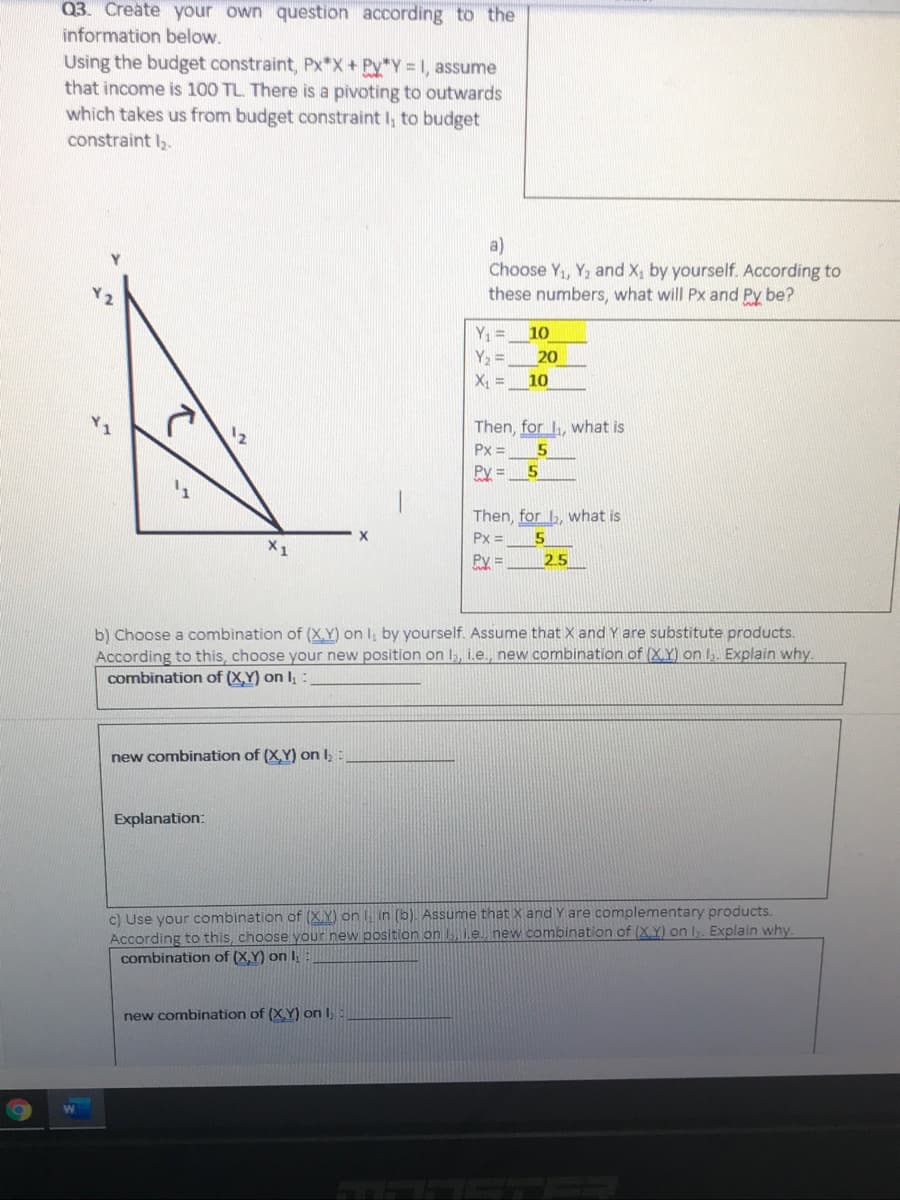Q3. Create your own question according to the information below. Using the budget constraint, Px*X+Py*Y 1, assume that income is 100 TL There is a pivoting to outwards which takes us from budget constraint I, to budget constraint I. a) Choose Y,, Y, and X, by yourself. According to these numbers, what will Px and Py be? Y = Y = X =_10 10 20 Then, for , what is Px = Py =_5 Then, for b, what is Px = Py = 2.5 b) Choose a combination of (X.Y) on I, by yourself. Assume that X and Y are substitute products. According to this, choose your new position on I,, i.e., new combination of (XY) on . Explain why. combination of (X,Y) on I; : new combination of (X_Y) on I, : Explanation: c) Use your combination of (X.Y) on in (b). Assume that X and Y are complementary products. According to this, choose your new position on e new combination of (X.Y) on I. Explain why. combination of (X,Y) on I new combination of (XY) on I,:
Q3. Create your own question according to the information below. Using the budget constraint, Px*X+Py*Y 1, assume that income is 100 TL There is a pivoting to outwards which takes us from budget constraint I, to budget constraint I. a) Choose Y,, Y, and X, by yourself. According to these numbers, what will Px and Py be? Y = Y = X =_10 10 20 Then, for , what is Px = Py =_5 Then, for b, what is Px = Py = 2.5 b) Choose a combination of (X.Y) on I, by yourself. Assume that X and Y are substitute products. According to this, choose your new position on I,, i.e., new combination of (XY) on . Explain why. combination of (X,Y) on I; : new combination of (X_Y) on I, : Explanation: c) Use your combination of (X.Y) on in (b). Assume that X and Y are complementary products. According to this, choose your new position on e new combination of (X.Y) on I. Explain why. combination of (X,Y) on I new combination of (XY) on I,:
Micro Economics For Today
10th Edition
ISBN:9781337613064
Author:Tucker, Irvin B.
Publisher:Tucker, Irvin B.
Chapter6: Consumer Choice Theory
Section6.A: Indifference Curve Analysis
Problem 2SQP
Related questions
Question

Transcribed Image Text:Q3. Create your own question according to the
information below.
Using the budget constraint, Px*X+ Py*Y 1, assume
that income is 100 TL. There is a pivoting to outwards
which takes us from budget constraint I, to budget
constraint l,.
a)
Choose Y1, Y, and X, by yourself. According to
these numbers, what will Px and Py be?
Y =
10
Y2 =
X, =
20
10
Then, for , what is
Px =
Py =
Then, for , what is
Px =
5
Py =
2.5
b) Choose a combination of (X.Y) on I, by yourself. Assume that X and Y are substitute products.
According to this, choose your new position on 1,, i.e., new combination of (X.Y) on I,. Explain why.
combination of (X,Y) on I; :
new combination of (X.Y) on I,:
Explanation:
c) Use your combination of (X.Y) on in (b). Assume that X and Y are complementary products.
According to this, choose your new position on , i.e. new combination of (X.Y) on I. Explain why.
combination of (X,Y) on I
new combination of (XY) on I,
Expert Solution
This question has been solved!
Explore an expertly crafted, step-by-step solution for a thorough understanding of key concepts.
Step by step
Solved in 2 steps with 3 images

Knowledge Booster
Learn more about
Need a deep-dive on the concept behind this application? Look no further. Learn more about this topic, economics and related others by exploring similar questions and additional content below.Recommended textbooks for you



